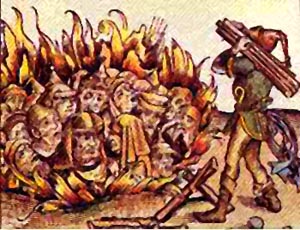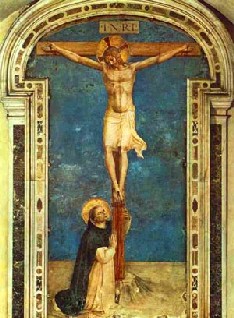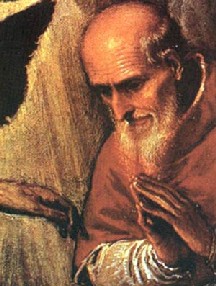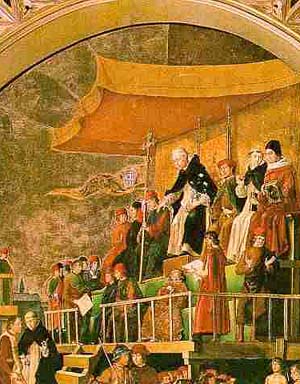I am referring to the John Paul II’s letter of June 15, 2004 addressed to Cardinal Roger Etchegaray on the occasion of the release of the “Report of the International Symposium on the Inquisition.” In it, he reiterated the apology he made in his Apostolic letter Tertio millennio adveniente. He also repeated the petition of forgiveness he offered on the year 2000 Day of Forgiveness (March 12). This apology, he stated, would be “valid” for the “dramas linked to the Inquisition as well as for the wounds they have caused in the memory.”
 |
The Symposium released findings that debunk the black legends of the Inquisition, such as the notion that Catholics burned heretics indiscriminately by the hundreds. |
It isn’t really possible to either speak about or ask forgiveness in general for the Inquisition, Cardinal George Cottier, a member of the Symposium, pointed out. The Inquisition per se did not exist, he noted, so how can you ask forgiveness for an image spread by public opinion, which is part of a myth and does not correspond to reality? (Zenit, June 15, 2004)
 |
St. Dominic, above, later referred to by his followers as the persecutor haereticorum [persecutor of heresies]. |
The most famous and much maligned Spanish Inquisition was established in 1478 by Pope Sixtus IV in response to numerous complaints Rome was receiving from southern Spain about the many heresies and immoralities introduced into Catholic doctrine by false believers and converts. I refer you to a booklet written by three priests of Miles Iesu [Soldier of Christ society] entitled Why Apologize for the Spanish Inquisition? The priests present findings of modern scholars on the topic and correctly conclude that the world is indebted to the Catholic Church for establishing the tribunal of the Spanish Inquisition, because “its legality, fairness and clemency due to Catholic thinking based on the consistent moral teaching of the Catholic Church saved millions of souls from confusion, contradiction, hatred, poverty and death” (Chicago: Miles Iesu, 2000, p. 27).
At the June 15 press conference in Rome, Agostino Borromeo, symposium spokesman, pointed out how the Spanish Inquisition held far fewer trials than had been supposed and employed a direct and open policy throughout the trial procedure. The accused condemned to death comprised only 1.8%, and this includes the 1.7% condemned in “contumacy,” that is, burned or hanged in effigy since their whereabouts were unknown. Which means that only .1% of those tried by the Spanish Inquisition were actually burned or hanged (Zenit, June 5, 2004).
About the notorious “witch hunts,” Borromeo again confirmed what scholars have been demonstrating for the last couple of decades. Most of the witch burnings of modern Europe (and there was almost none in the medieval period) occurred under Protestant tribunals, not under the Inquisition in Catholic countries. Quite the opposite, it was the Catholic Inquisition in Spain that often intervened to defend the women accused of being witches, just as it protected Jews from mob lynching frenzies. Here are some of the symposium’s figures: witches burned in Switzerland under Protestant tribunals: 4,000; in Spain under the Catholic Inquisition during the same period: 39 (ibid.).
 |
St. Pius V, when still a Cardinal, was named Grand Inquisitor. |
1) The Prosecution of Heresy: Collected Studies on the Inquisition in Early Modern Italy (Binghampton, NY: 1991), 7-9.Drumhead courts, torture chambers, or judicial labyrinths with no escape impossible simply never existed; there was no such “Inquisition.” Therefore, general condemnations and consequent apologies for an abstract “Inquisition” are wrong in principle, since they do not consider the particular reality of these different institutions. To condemn “The Inquisition” would be as wrong as condemning “The University” in general, without identifying any particular one or ones. Such condemnations of this splendid institution appear to be just more fuel being poured on the revolutionary fire that is trying to extinguish the militancy of the Church.
 |
Recent data show that the Spanish Inquisition was both fair in its methods and just in its punishments. |
Why would he make this new apology? At the very moment when significant data are presented to the world destroying the black myth of the Inquisition, why would he make a plea of forgiveness for “methods of intolerance” that have “disfigured the countenance of the Church”? (“John Paul II Letter on Inquisition Symposium,” Zenit, June 15, 2004). Is it to further confuse an already muddled up matter? Certainly the attitude he took is highly confusing… Does his apology signify a split in the Vatican, with the Pope taking the side of the progressivists against the scholarly findings?
At any rate, his condemnation of a laudable institution that defended the Faith placed at risk is to pass the judgment that the Church should accept all the heresies and errors of her enemies. Which, in my opinion, is equivalent to attacking Catholic militancy and promoting the destruction of the Church.
Instead of an apology, think how much good it would have done us to hear a clear assertion from the Supreme Pontiff that the Inquisition was correct in its procedures and fair in its punishments. Instead of a sniveling position of self-blame for all the evils of History, the Church should proudly affirm her militant past and the sound institutions she developed to keep herself free of heresy, error and injustice. One such institution was the Inquisition.
The Symposium’s report helped to affirm this. Why didn’t the Pope?
